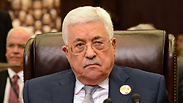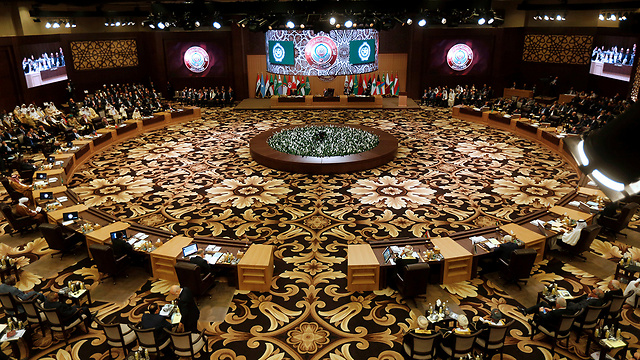
Palestinian President Mahmoud Abbas at the Arab League summit
צילום: AFP
There is an outline for peace, but is there a partner?
Op-ed: The chance of reaching a peace agreement with the Palestinians is almost nonexistent, but that doesn’t mean there is nothing Israel can do to get closer to a regional agreement. The first step—a construction freeze outside the settlement blocs—has already been taken, and if that’s happening other things can happen too.
The chance to bridge the gaps between Israel and the Palestinians is almost nonexistent. Only last week, during the Arab League summit, the Arab leaders revived the Arab peace initiative. It should not be downplayed, and it should not be rejected out of hand. But we should pay attention to Palestinian President Mahmoud Abbas’ comments: He stressed that the initiative should be accepted as is, with all its sections, referring primarily to the “right of return.” He knows there is no chance that any government in Israel, including a Meretz-led government, will agree to that. Nevertheless, he is reiterating the demand, which means: I am not a partner for peace.

There are two facts we must not ignore, however. First of all, unlike other areas in which Trump is gaining more and more failures, in the Arab world he is actually getting off on the right foot. There are only two issues the Arab-Sunni world is united on: Iran and Israel. It sees Iran as an enemy and Israel as a partner, as long as an agreement with the Palestinians is achieved. Trump is portrayed as the Arab world’s partner on these two points. He is stepping up his hostile statements against Iran, and the agreement that is being formed for a settlement construction freeze outside the existing communities is an achievement that even former President Barack Obama never dreamed of.

Arab League summit in Jordan. When discussing a regional alliance or a regional summit or a new initiative today, we should return to the old Arab agreement (Photo: Reuters) (צילום: רויטרס)
Is there a chance to bridge between the Arab initiative and Israel? It should be noted that there was once a point of agreement between the parties. It happened in late 2000, after then-US President Bill Clinton presented his parameters for Israeli-Palestinian peace. The guidelines he presented included recognizing Israel as the Jewish people’s national home and solving the refugee problem not through a mass return to Israel. Clinton pressed the leaders of the important Arab states—Saudi Arabia, Egypt, Jordan and Morocco—and the pressure worked. The leaders, at least according to Prince Bandar bin Sultan, the Saudi ambassador to the United States at the time, adopted the parameters. It was the first time that leaders of Arab states agreed to recognize Israel as the Jewish people’s national home. The Israeli government, led by Ehud Barak, made a dramatic decision as well, giving a positive answer.
The Palestinians were and remain the impassable barrier. The Arab states demanded that then-Palestinian Chairman Yasser Arafat accept the Clinton parameters. That’s didn’t help. The Palestinians agreed to two states, but not to two people. That explains Abbas’ insistence, even last week, on the “right of return.”
When discussing a regional alliance or a regional summit or a new initiative today—we should return to the old Arab agreement. In this state of affairs, even if Netanyahu isn’t eager to adopt the Clinton parameters, he can afford to be flexible. Because if he says yes, the Palestinians will say no. It won’t be a change of direction on Netanyahu’s part. During his talks with former US Secretary of State John Kerry, Netanyahu was surprisingly flexible. He agreed to an Israeli withdrawal from 90 percent of Judea and Samaria. The details have been exposed. Netanyahu didn’t admit it, but he didn’t deny it either.
It’s unlikely that Trump and the Arab states’ leaders will succeed in making the Palestinians budge from their position. It’s unlikely that the Arab states will publicly recognize Israel as a Jewish state and/or withdraw from the right of return demand. But it’s possible to come up with an outline that would be accepted by Israel, the US and the Arab states’ leaders. A shelf draft agreement. The first clause of the outline is essentially already being launched: The construction freeze outside the existing communities in Judea and Samaria. It doesn’t take much more than that to prevent the crawling disaster of one big state. This can be continued with further steps which will allow other cities in the West Bank to advance to a “Jenin model” of economic welfare.
The chance of reaching a peace agreement, let me reiterate, is almost nonexistent—but that does not mean that there is nothing to do, that we can’t get closer to a regional agreement, that everything must remain as it is now. The first step has been taken, and if that’s acceptable and it’s happening—other things can happen too. Inshallah.
(Translated and edited by Sandy Livak-Furmanski)










